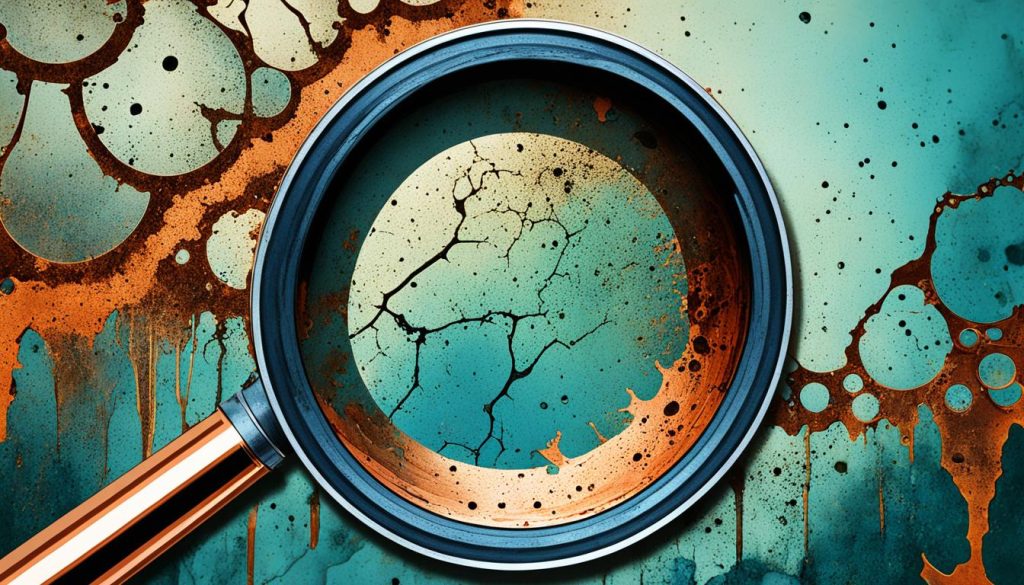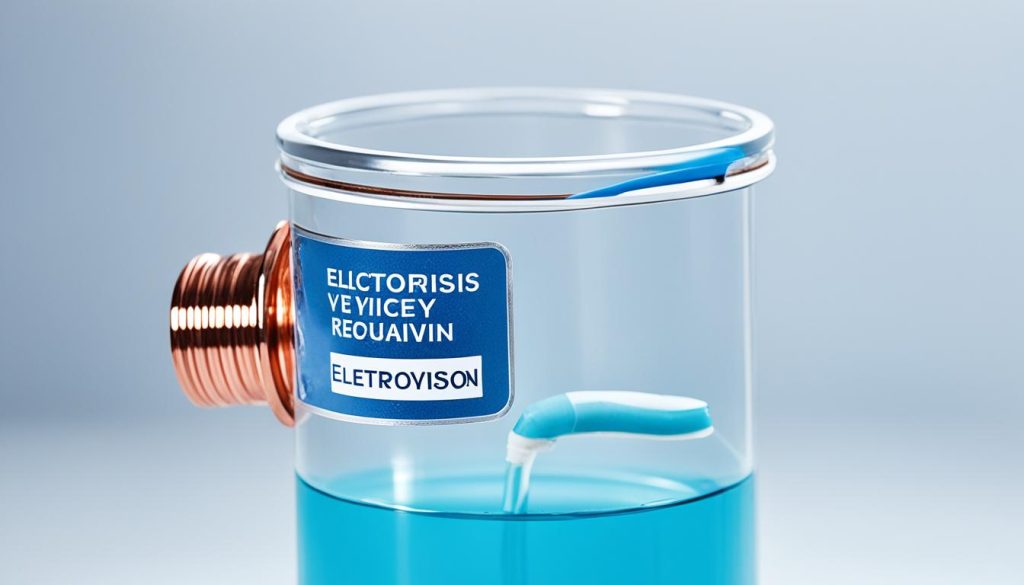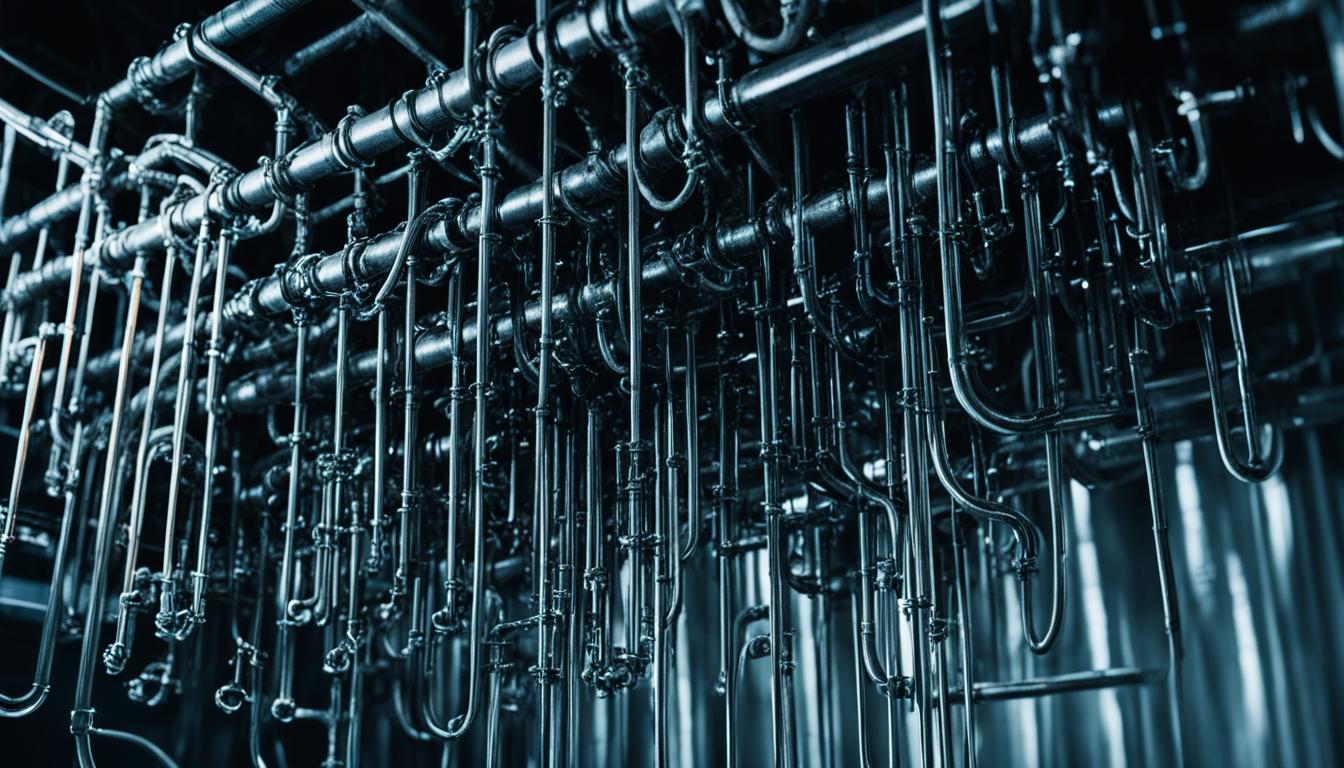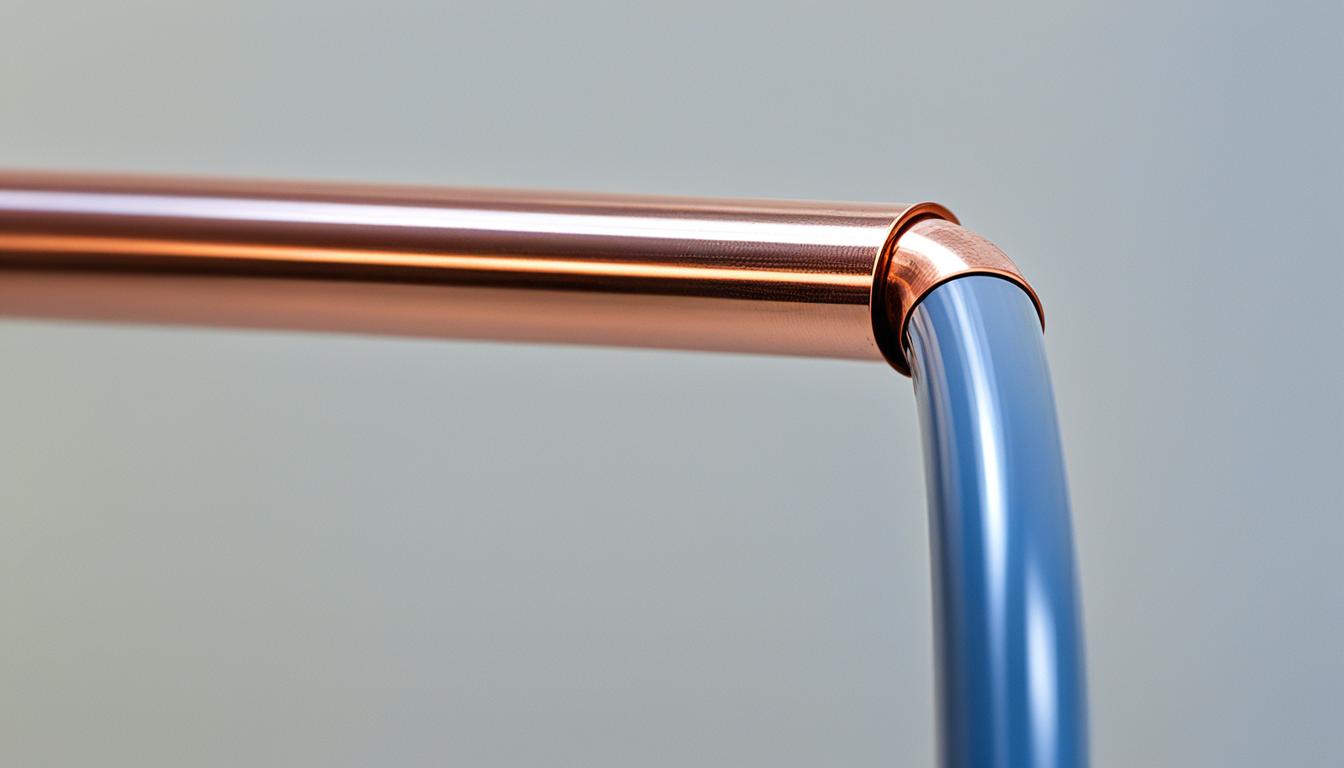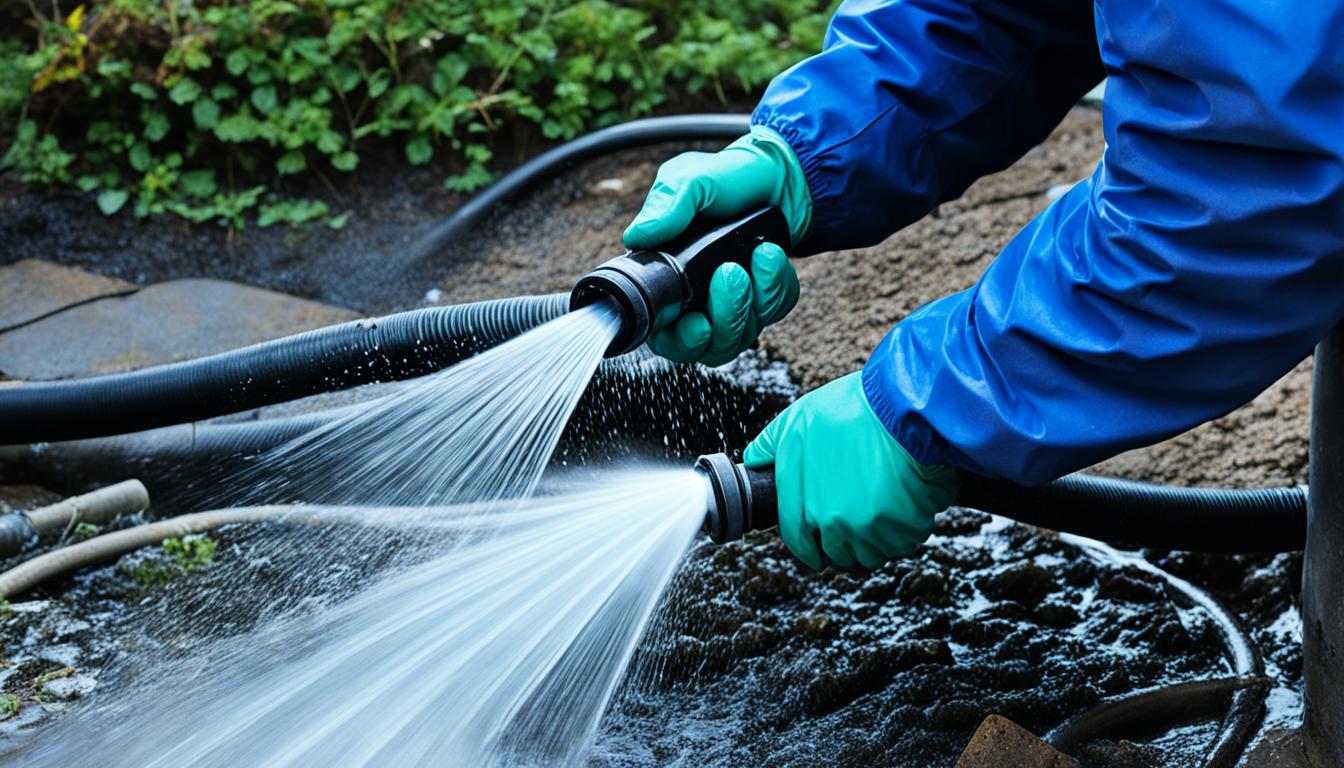Electrolysis Copper Pipe: Causes and Solutions
Did you know that electrolysis in copper pipes can cause significant corrosion and damage? This often misunderstood phenomenon can result in costly repairs and water leaks in plumbing systems. Understanding the causes and implementing preventive measures is crucial to protect your copper pipes.
Key Takeaways:
- Electrolysis in copper pipes can lead to corrosion and water leaks.
- Galvanic corrosion, not true electrolysis, is the primary cause of copper pipe deterioration.
- Common causes of electrolysis include electrical faults, contact with dissimilar metals, and stagnant water.
- Electrolysis damage can be identified by green discoloration and pitting on copper pipes.
- Preventive measures such as dielectric couplings and encasing copper pipes in plastic can help prevent electrolysis.
Common Causes of Electrolysis in Copper Pipes
Electrolysis in copper pipes can occur due to various factors, leading to galvanic corrosion and deterioration of the copper pipe. Understanding the common causes of electrolysis is essential for identifying and preventing potential damage.
Electrical Fault to Earth
One of the most frequent causes of electrolysis in copper pipes is an electrical fault to earth. This fault can be caused by faulty wiring or grounding systems, resulting in the flow of electrical current through the copper pipes. It is advisable to seek assistance from a local electrician to diagnose and address any electrical faults.
Contact with Dissimilar Metals
When copper pipes come into contact with dissimilar metals such as galvanized steel, brass, or other copper pipes, galvanic action can occur. This reaction arises due to the electrical potential difference between the metals, causing accelerated corrosion of the copper pipe.
Stray DC Current from Modern Appliances
Modern appliances that generate stray DC current, such as hairdryers, can contribute to electrolysis in copper pipes. These appliances, when in contact with the plumbing system, can introduce direct current into the pipes, leading to galvanic corrosion over time.
Stagnant Water and Bacterial Content
Stagnant water and high bacterial content in the plumbing system can exacerbate the electrolysis process in copper pipes. The presence of stagnant water creates an ideal environment for the growth of bacteria, which can produce corrosive byproducts that contribute to copper pipe deterioration.
Iron Deposits
Iron deposits in the plumbing system can also accelerate the deterioration of copper pipes. The interaction between iron and copper, along with the presence of electrolytes like water, can initiate galvanic corrosion and contribute to the weakening of the copper pipe.
Understanding these common causes of electrolysis in copper pipes is crucial for implementing preventive measures and ensuring the longevity of the plumbing system. By addressing these factors, homeowners can mitigate the risk of galvanic corrosion and preserve the integrity of their copper pipes.
Detecting and Identifying Electrolysis Damage
When it comes to electrolysis damage in copper pipes, detection is key. Unfortunately, this type of damage is often not discovered until a water leak occurs, leading to costly repairs and potential water damage. It’s essential to identify the signs of electrolysis damage early on to prevent further deterioration of the copper pipes.
One common indication of electrolysis damage is green discoloration on the surface of the copper pipe. This green hue, also known as verdigris, results from the oxidation of the metal due to the presence of an electrical current. Additionally, pitting or small holes may appear on the surface of the pipe, further confirming the presence of electrolysis damage.
However, to truly assess the extent of electrolysis damage, a closer inspection of the pipe’s interior is necessary. Inside the pipe, signs of corrosion may be evident, with a rough, crater-like appearance. This damage can compromise the structural integrity of the pipe, leading to leaks and potential water damage.
To ensure the longevity and proper functioning of your copper pipe system, it’s crucial to locate the source of electrolysis damage as soon as possible. Once identified, appropriate measures can be taken to prevent further damage and maintain the integrity of the plumbing system.
If electrolysis damage is present in both hot and cold water lines, it may be necessary to replace the entire copper pipe system with plastic potable water pipes. This proactive approach helps mitigate future electrolysis damage and ensures the durability of the plumbing system.
Signs of Electrolysis Damage
| Signs | Description |
|---|---|
| Green Discoloration | Visible green hue (verdigris) on the surface of copper pipe due to oxidation |
| Pitting | Small holes or pits on the surface of the copper pipe |
| Corrosion | Rough, crater-like appearance on the interior of the copper pipe |
Preventing Electrolysis in Copper Pipes
To prevent electrolysis in copper pipes, there are several effective measures that can be taken. One approach is the use of dielectric couplings, which help to break the flow of electricity between different metal pipes. However, it’s important to note that the use of dielectric couplings may be subject to local regulations.
Another effective method for preventing electrolysis is to fully encase the copper water line in PVC plastic or a similar protective tubing. This helps to isolate the copper from any direct contact with other metal pipes or electrical currents. It’s recommended to use approved tape to cover any exposed areas of the copper to ensure complete protection.
Additionally, the use of dielectric unions at connecting points can further help to interrupt the flow of electricity and prevent electrolysis. These unions are designed to provide a barrier between different metals, reducing the risk of galvanic corrosion.
When it comes to preventing electrolysis in copper pipes, it is crucial to hire a licensed and experienced plumber who understands the causes and prevention of electrolysis. They will ensure the proper installation and protection of water service lines, minimizing the risk of electrolysis damage.
| Preventive Measures | Benefits |
|---|---|
| Use of dielectric couplings | Helps break the flow of electricity between different metal pipes |
| Encasing the copper water line in PVC plastic or similar tubing | Provides complete isolation and protection for the copper pipe |
| Using approved tape to cover exposed areas of the copper | Ensures no direct contact between the copper and other materials |
| Installing dielectric unions at connecting points | Creates a barrier between different metals, reducing the risk of galvanic corrosion |
Stray Electrical Currents and Copper Pipe Electrolysis
When it comes to copper pipe electrolysis, stray electrical currents play a significant role in causing damage and corrosion. These stray currents are commonly found in areas near electric railway tracks and cathodic protection systems for gas mains. The presence of direct current (DC) electricity can be a major contributing factor to electrolysis in copper pipes.
A key source of these electrical currents is the MTA subway system and damaged underground utility lines. The flow of DC electricity through the copper pipes leads to electrolysis, resulting in corrosion and potential water line breaks. Additionally, areas with solid-state appliances may experience an increased risk of electrolysis-related damage to copper pipes.
To prevent further damage and ensure the longevity of your copper pipes, it is crucial to choose a qualified plumbing contractor who thoroughly understands the causes and effective treatment methods for electrolysis. By addressing the issue promptly and taking appropriate preventive measures, you can protect your plumbing system from the detrimental effects of stray electrical currents.
Preventing Electrolysis: Best Practices
Here are some best practices to consider when safeguarding your copper pipes from electrolysis:
- Ensure proper grounding and electrical wiring in your home or building.
- Avoid using dissimilar metals in close proximity to your copper pipes.
- Install dielectric unions at connecting points to interrupt the flow of electrical current.
- Consider fully encasing the copper pipes in non-metallic materials like PVC to protect them from contact with electrical currents.
- Regularly inspect and maintain your plumbing system to detect any signs of electrolysis damage early on.
By implementing these preventive measures and working with a knowledgeable professional, you can minimize the risk of electrolysis and preserve the integrity of your copper pipes.
| Signs of Electrolysis Damage | Preventive Measures |
|---|---|
| Green discoloration and pitting on the surface of copper pipes. | – Ensure proper grounding and electrical wiring – Avoid using dissimilar metals in close proximity |
| Rough, crater-like corrosion on the inside of the pipe. | – Install dielectric unions at connecting points – Fully encase copper pipes in non-metallic materials |
| Leakage and water line breaks. | – Regularly inspect and maintain plumbing system |
Case Study: Underground Copper Pipe Electrolysis in Brooklyn
In a recent case study conducted in Brooklyn, I examined the destructive impact of underground copper pipe electrolysis. The findings revealed that improper installation by a previous contractor led to a water main break within a remarkably short period of three years.
It was discovered that the copper water line had been installed at a shallow depth and forced through electric ducts, resulting in the flow of electricity into the ground and subsequent corrosion of the copper pipe. To repair the water line effectively, proper installation at a greater depth, away from electrical lines, was required.
This case study underscores the importance of choosing a reputable water main contractor who can ensure correct installation procedures and prevent future instances of electrolysis-related damage. By employing the services of a trusted professional, homeowners can minimize the risk of underground copper pipe deterioration and maintain the integrity of their plumbing system for years to come.
Summary of Case Study Findings
| Key Factors | Description |
|---|---|
| Previous Installation | Improper installation by a previous contractor |
| Duration until Break | Water main break occurred within three years |
| Depth of Installation | Copper water line installed at a shallow depth |
| Presence of Electric Ducts | Copper pipe forced through electric ducts |
| Corrosion and Damage | Electrolysis caused corrosion and deterioration of the copper pipe |
| Repair Solution | Proper installation at a greater depth, away from electrical lines |
As illustrated in the table above, the case study highlights the critical role that comprehensive installation practices play in mitigating the risks associated with copper pipe electrolysis. By implementing appropriate measures, such as proper depth and avoiding contact with electrical infrastructure, homeowners can effectively address electrolysis and prevent future instances of copper pipe deterioration.
Solutions and Precautions for Electrolysis in Copper Pipes
To effectively address electrolysis in copper pipes, it is crucial to implement precautionary measures. One solution is to install dielectric unions at connecting points, which can help prevent the flow of stray electrical current. Another option is to use plastic sleeves, such as PVC, to encase the copper tubing. This protective layer acts as a barrier, minimizing direct exposure of the copper to potential electrical currents.
In some cases, opting for non-metallic water service lines can be a viable solution. These lines are not susceptible to the same galvanic reactions as copper pipes, reducing the risk of electrolysis. However, it is important to note that such an installation requires the expertise of a skilled and licensed professional to ensure proper implementation.
When dealing with electrolysis in copper pipes, it is crucial to choose a trustworthy and knowledgeable plumbing contractor who can provide effective treatment and long-term solutions. Their expertise in electrolysis treatment and copper pipe maintenance can help mitigate the risks of further damage, ensuring the longevity and efficiency of your plumbing system.
Source Links
- https://copper.org/applications/plumbing/techcorner/electrolysis_cause_copper_tube_fail.php
- https://www.moyleplumbing.com.au/handy-hints-blog/electrolysis-in-copper-pipe
- https://www.balkanplumbing.com/copper-pipe-electrolysis-water-main-killer/
- Investing Wisely: How Windows & Doors in Boost Property Value and Financial Health - April 24, 2025
- The Financial Impact of Personal Injuries: Why Legal Help Matters for Business Owners - April 16, 2025
- The Hidden Financial Costs of Domestic Assault: What Business Owners Need to Know - April 16, 2025
